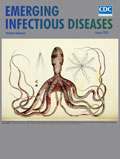
Volume 26, Number 8—August 2020
Dispatch
Genotypic Heterogeneity of Orientia tsutsugamushi in Scrub Typhus Patients and Thrombocytopenia Syndrome Co-infection, Myanmar
Aye Marlar Win1, Yen Thi Hai Nguyen1, Yuri Kim1, Na-Young Ha, Jun-Gu Kang, Hongil Kim, Bo San, Okkar Kyaw, Wah Win Htike, Dong-Ok Choi, Keun-Hwa Lee2 , and Nam-Hyuk Cho2
, and Nam-Hyuk Cho2
Abstract
Serologic and molecular surveillance of serum collected from 152 suspected scrub typhus patients in Myanmar revealed Orientia tsutsugamushi of genotypic heterogeneity. In addition, potential co-infection with severe fever with thrombocytopenia syndrome virus was observed in 5 (3.3%) patients. Both scrub typhus and severe fever with thrombocytopenia syndrome are endemic in Myanmar.
Scrub typhus is a miteborne febrile illness caused by the bacterium Orientia tsutsugamushi, which is endemic in the Asia-Pacific region and a major cause of undifferentiated febrile disease (1). O. tsutsugamushi infections were documented in Myanmar during the 1940s (2). Since then, however, no report has described the prevalence and genetics of scrub typhus in Myanmar, although 2 studies, including 1 from 2017, identified scrub typhus as one of the primary infections causing acute febrile illness on the Thailand–Myanmar border (3,4). These results underscore the need for research on this vectorborne infection in Myanmar, including studies defining the genotypic diversity of O. tsutsugamushi. Lack of this information has been a serious obstacle to developing effective diagnostic methods and a vaccine for scrub typhus (1).
The tickborne virus severe fever with thrombocytopenia syndrome virus (SFTSV), of the genus Banyangvirus, can cause hemorrhagic fever with a mortality rate of up to 40% (5). SFTSV infections are endemic in eastern Asia, and retrospective studies have confirmed its presence in China in 1996 (6), South Korea in 2000 (7), Japan in 2005 (8), and Vietnam in 2017 (9). In addition, mixed infection with SFTSV and O. tsutsugamushi has been detected in patients in South Korea, where both pathogens are endemic (7,10). These results further emphasize the urgent need for epidemiologic studies of vectorborne diseases in areas of endemicity to improve our ability to accurately differentiate febrile infectious diseases with atypical signs and symptoms during the initial stages so they can be promptly treated. Here, we used blood samples from suspected scrub typhus patients in Myanmar to investigate the serologic prevalence and genotypic diversity of O. tsutsugamushi. We also examined these patients for possible co-infection with SFTSV, which has been an emerging threat to public health in eastern Asia.






















.png)











No hay comentarios:
Publicar un comentario